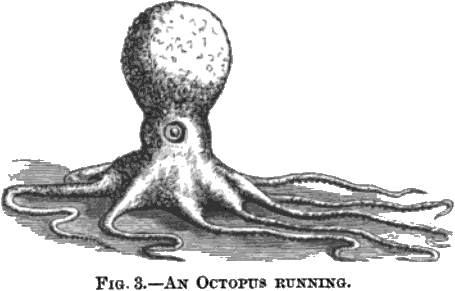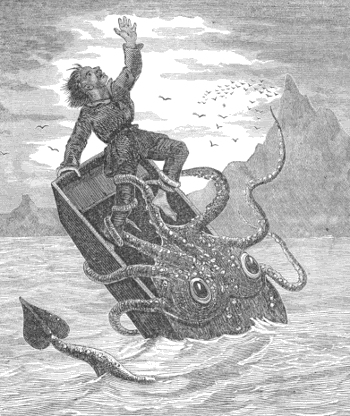
The vulnerable portion of the octopus is the neck, and fishermen and others, who know their habits when attacked, always strive if possible to seize them by the throttle-valve, when they are easily killed. This is comparatively easy on land, but nearly impossible in the water. The locomotion of the devil-fish is as easy on land as in the water. They have been known frequently to run up perpendicular cliffs, two hundred feet high, as easily as the fly runs up a wall, the machinery of attachment being very similar. They are said to move on land as fast as a man can run, and frequently pursue their prey out of the sea, though on the land they are far more timid than in their marine haunts. [From World of Wonders (1881).]
The "octopus running" illustration above appeared earlier in Ocean Wonders (1879) by William Emerson Damon, published by D. Appleton, the same company that published the above. The chapter it's found in was excerpted in the Jan., 1879 issue of Popular Science, which was probably more widely read. Damon's accompanying text has more detail:
I should have mentioned that if it is desired to preserve the octopus alive, the pressure on the neck should not be too severe, for that is their vulnerable point; and a person attacked by one should never lose time in striving to loosen its arms, but grasp if possible this portion connecting the head and body, in which way they may be easily killed.
In regard to their powers of locomotion upon land, on which there has been considerable controversy, I can assure the reader that I have seen a full-grown octopus at the Bermudas spring up out of the water, only a few feet forward of the boat I was in, and run up a perpendicular rocky cliff for more than two hundred feet! This ledge of rock bore a general resemblance to our Hudson River Palisades at their steepest portion. We soon learned the cause of this seemingly strange performance, when we discovered one of those beautiful bright-red crabs, which are native to the locality, trying to escape from the clutches of this devil-fish. The crab, being frightened almost out of its simple wits, had run up the rocks for safety; but its tactics proved sure death in the end. As to the speed of the octopus, it appeared to me to travel much faster than I could run. At least, I should not care, if unarmed, to engage in a race with one, unless Mr. Devil started a good way ahead.
The chapter also has this image of "The Giant Squid", which I'm including for no other reason than its general awesomeness:
Anyway, back to the running octopus... the illustration is interesting. First of all, I'm not sure where it originated. The earliest appearance I can find is an article in Appletons' Journal (Oct. 9, 1875) describing it merely as "an Octopus crawling". The Appleton company seemed to be fond of the image since it also appeared in their Glimpses of the Animate World (1885) by James Johonnot and Along the Florida Reef (1892) by Charles Frederick Holder, both using the "octopus running" caption.
The textbook Zoology for High Schools and Colleges (earliest version Google has is 1879), by Alpheus Spring Packard (published by Henry Holt & Co.), has a version of the image labeled "Poulpe or Common Octopus of Brazilian Coast", with no mention of it running or being above water. At first glance it's identical to Appleton's, but it's larger and the shading and texture are different. Either Appleton's was copied from this version, or this from Appleton's, or both from some other source.
Besides it being used to depict an octopus running on the ground, the most interesting thing about the image is that it looks like the octopus has only one, huge, centrally mounted eye. Octopuses don't look like this, of course, whether on land or in water; although their shape is malleable, their two eyes typically protrude very conspicuously upwards, in some instances almost stalk-like.
However, one-eyed cephalopods or pseudo-cephalopods -- especially ones that scuttle across the ground -- are not uncommon in cheesy sci-fi/horror comics, movies, etc. from decades past. The concept was famously satirized on the Simpsons with the space aliens Kodos and Kang, who were supposedly based on a design from an old EC Comic cover. (Also see this post on the blog Pharyngula with an example from the 1954 movie Monster from the Ocean Floor -- I'm sure there's many other examples, but I don't want to go off on too far a tangent from my original intent for this post.)
So where did this one-eyed cephalopod idea come from? Squid, if aligned vertically and viewed from one side, give a cyclopean impression that probably influenced the popular depiction, but they don't travel in that upright position, as is usually the case with one-eyed cephalopods in fiction. Could Appleton's odd image and the sensationalistic description accompanying it, perhaps from its appearance in Popular Science, be the ultimate origin of this anatomically incorrect motif?
LATE UPDATE: The Packard version of the image I mentioned above appears earlier in an 1872 issue of The American Naturalist, co-edited by Packard. It's used as an illustration for a small news report on a giant octopus found in the Bahamas, with an editors' note that it's actually of a Brazilian octopus. And then there's this: Alpheus Spring Packard Jr.'s mother was the daughter of Rev. Jesse Appleton, president of Bowdoin College and presumably connected to the publisher D. Appleton, which I guess explains the use of the image by both Packard and Appleton. Now I'm definitely going off on a tangent (and one a lot less fun than old movie posters and pulp covers,) so if you're interested in the family history of the Packards and Appletons, you can go research the rest yourself.

